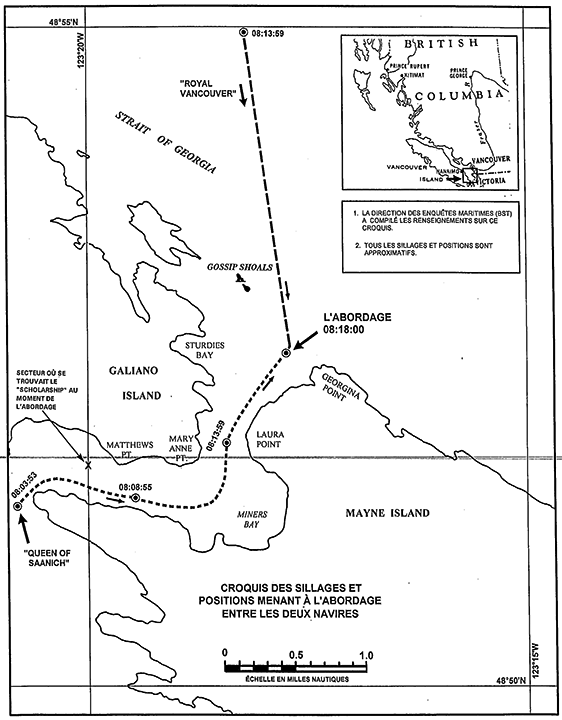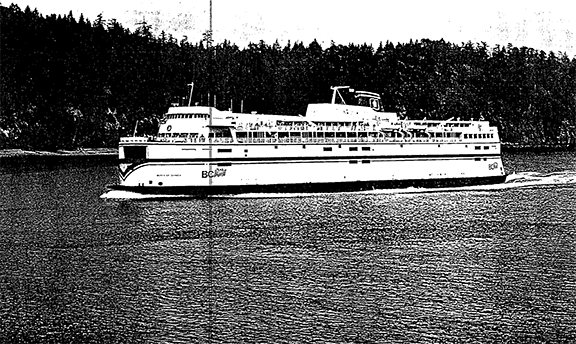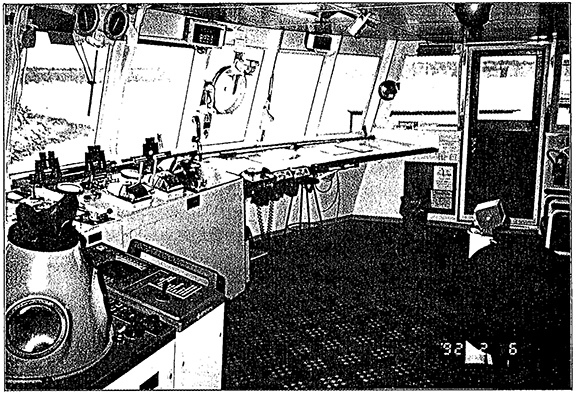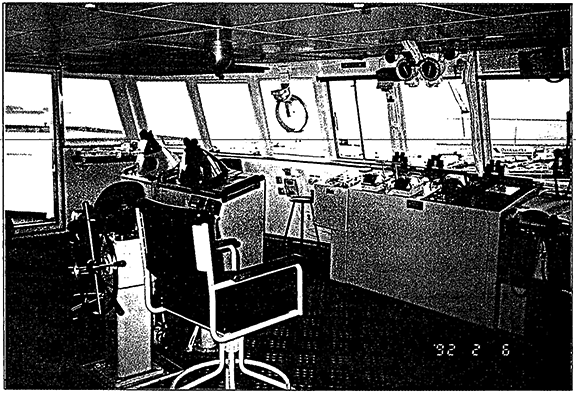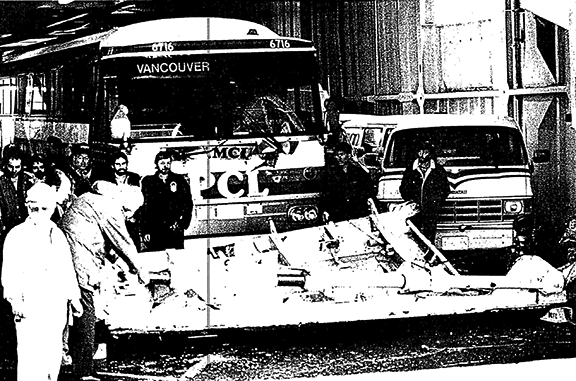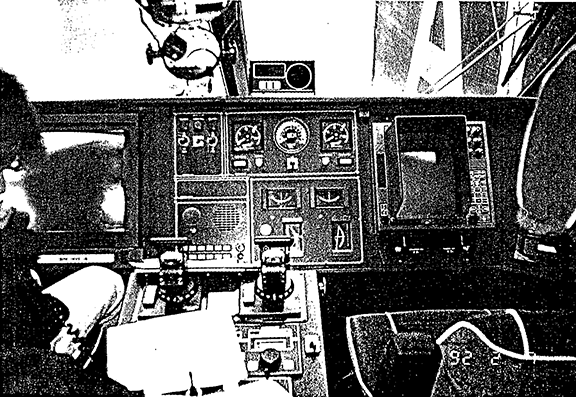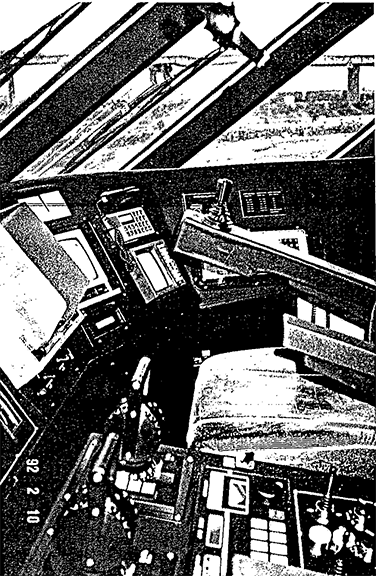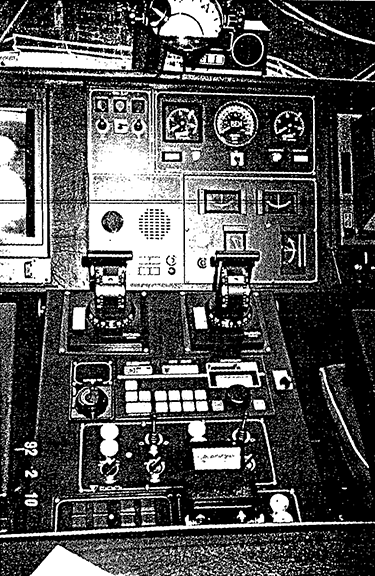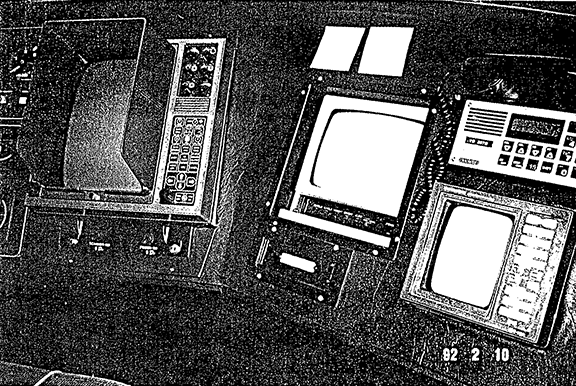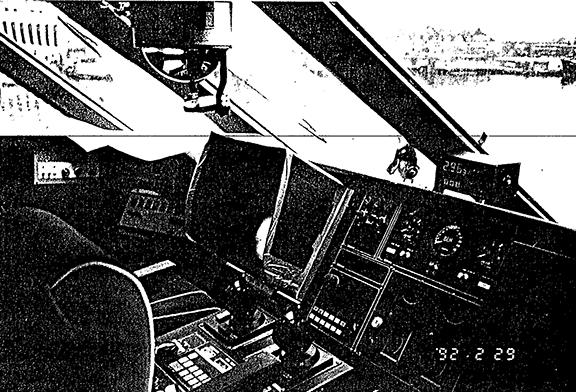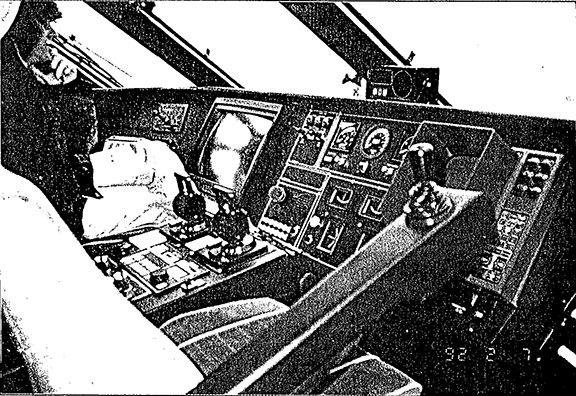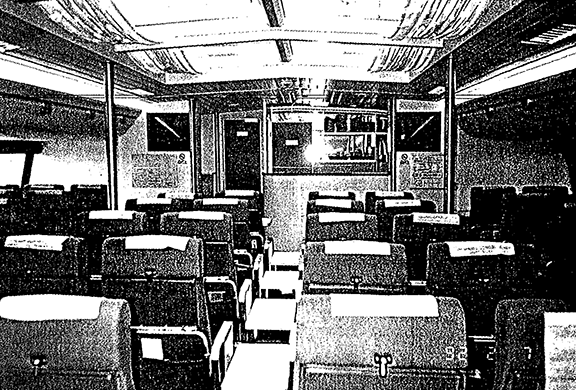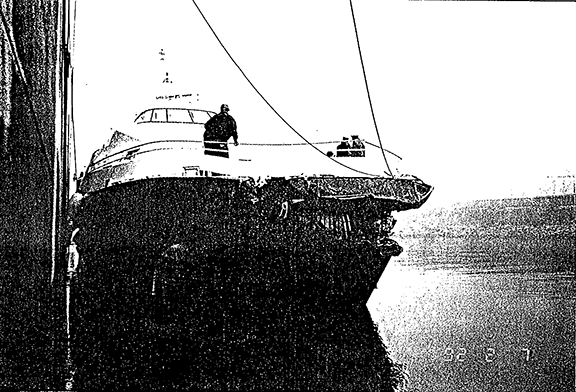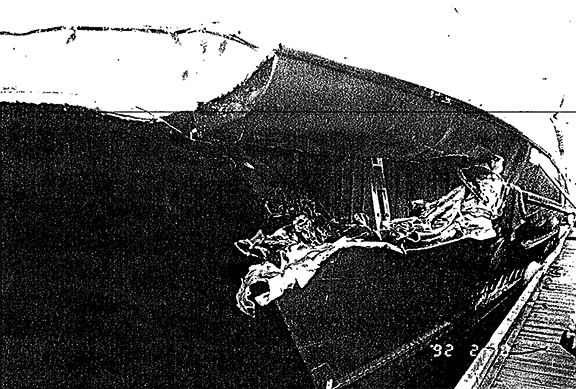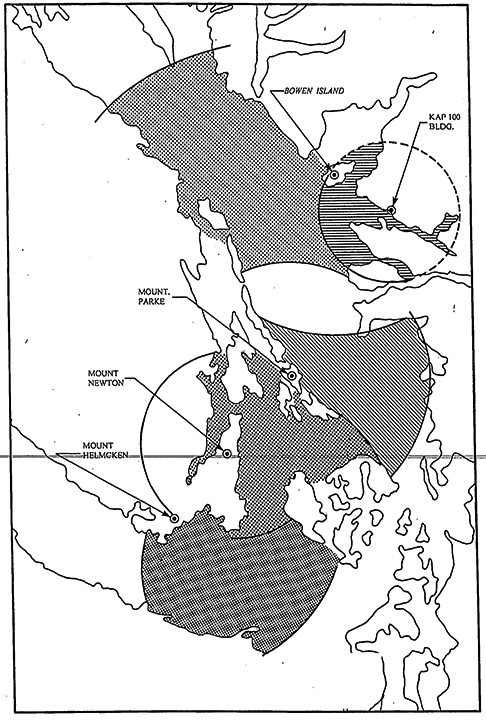Collision
between the Canadian ferries
"QUEEN OF SAANICH" and "ROYAL VANCOUVER"
Northern entrance to Active Pass
British Columbia
The Transportation Safety Board of Canada (TSB) investigated this occurrence for the purpose of advancing transportation safety. It is not the function of the Board to assign fault or determine civil or criminal liability. This report is not created for use in the context of legal, disciplinary or other proceedings. See Ownership and use of content. Masculine pronouns and position titles may be used to signify all genders to comply with the Canadian Transportation Accident Investigation and Safety Board Act (S.C. 1989, c. 3).
Summary
At 0818, 06 February 1992, in light airs, calm sea and fog, the catamaran passenger ferry "ROYAL VANCOUVER" and the British Columbia Ferry Corporation vehicle/passenger ferry "QUEEN OF SAANICH" collided head-on off Georgina Point at the northern entrance to Active Pass, British Columbia. On board the "ROYAL VANCOUVER", which was extensively damaged, 19 passengers and 4 crew members were injured. The bow doors of the "QUEEN OF SAANICH" were also damaged.
The Board determined that the bridge team of the "ROYAL VANCOUVER" did not positively identify and track a radar target and, as a result, altered course into the projected path of the "QUEEN OF SAANICH" about one minute before the collision. Contributing to the situation was the bridge team's limited experience with the catamaran's equipment.
1.0 Factual information
1.1 Particulars of the Vessel
| Name of vessel | "QUEEN OF SAANICH" | "ROYAL VANCOUVER" |
|---|---|---|
| Port of registry | Victoria, B.C.Footnote 1 | Vancouver, B.C. |
| Official number | 318669 | 815057 |
| Type | Ro-ro vehicle/passenger ferry | High-speed catamaran passenger ferry |
| Gross TonsFootnote 2 | 9,302 | 583 |
| Length | 130 m | 40 m |
| Breadth | 23.93 m | 10.1 m |
| Draught (depart Quebec--calc.) |
F: 3.27 m A: 4.11 m |
F: 1.35 m A: 1.55 m |
| Built | 1963, Victoria, B.C. | 1991, Norway |
| Propulsion | 2 x Mak cylinder diesels water jets 9,000 BHP | Diesel powered, eight-cylinder-twin KaMeWa (one in each hull), 5,370 BHP |
| Managing Owner | British Canadian Columbia Ferry Corporation Victoria, B.C |
Fast Ferry Corporation Vancouver, B.C |
1.1.1 Description of the Vessels
The "QUEEN OF SAANICH" is a ro-ro vehicle/passenger ferry with twin controllable-pitch propellers, twin rudders, two bow thrusters and a bulbous bow. Service speed is 18 knots (kn). The navigation bridge is located forward. The distance from bridge to bow is 16 m and from bridge to stern, 114 m. The vessel has an upper and a lower car deck and is fitted with bow and stern doors. The vessel was licensed to carry 1,163 passengers on this voyage. Photographs are shown at Appendix B.
The "ROYAL VANCOUVER" is a high-speed water-jet-powered catamaran passenger ferry of aluminium construction. Service speed is 35 kn. Passenger capacity is 218 on the main deck and 84 on the upper deck. Passenger lounges resemble the cabin design and seating arrangements of an airplane. Photographs are shown at Appendix C.
1.2 History of the Voyage
Shortly after 0700Footnote 3, 06 February 1992, the "QUEEN OF SAANICH" departed Swartz Bay ferry terminal, Vancouver Island, for Tsawwassen terminal on the mainland. At about the same time, the "ROYAL VANCOUVER" departed Vancouver Harbour for Victoria Harbour.
At 0749, the small passenger water taxi "SCHOLARSHIP" departed Ganges Harbour, Saltspring Island, bound for Sturdies Bay at the north-west entrance to Active Pass.
All three vessels participated in the Vancouver Vessel Traffic Services (VTS) reporting system.
The "QUEEN OF SAANICH" encountered fog on sailing and proceeded at a reduced speed. The vessel entered Active Pass at 0803 and, after rounding Mary Anne Point at 0811, she overtook the small fishing vessel "DEBBIE J" which was proceeding northbound and keeping close to the Mayne Island shoreline. Visibility was 0.05 nautical mile (M) in this area. Active Pass tracks and positions are shown at Appendix A.
The "ROYAL VANCOUVER" encountered thick fog on sailing; however, on clearing First Narrows, Lions Gate Bridge, visibility increased, and the vessel was run at full service speed prior to reaching Point Atkinson. The vessel passed due west of Iona Breakwater at 0746 and, at 0754, set course 164° True (T) and Gyro (G) to cross the Strait of Georgia. The radar heading marker was aligned on Georgina Point. Visibility in the Strait was 6 M. The crossing was uneventful.
Between 0812 and 0813, the "QUEEN OF SAANICH" and the "ROYAL VANCOUVER", with the assistance of the VTS reporting system, identified each other by radar. The "QUEEN OF SAANICH" was off Laura Point and the "ROYAL VANCOUVER" was in a position 3 M north of Active Pass.
At 0814, on learning the position of the "ROYAL VANCOUVER", the "SCHOLARSHIP" informed the catamaran by very high frequency radiotelephone (VHF R/T) that the "SCHOLARSHIP" was approaching Helen Point and that she would stay on the Mayne Island side of the channel. Helen Point is located at the south entrance to Active Pass. The "SCHOLARSHIP" suggested a red-to-red passing (port-to-port). The "ROYAL VANCOUVER" concurred with this arrangement. The "ROYAL VANCOUVER" began to reduce speed on approaching the fog bank at the entrance to Active Pass.
At 0816:30 the "QUEEN OF SAANICH" was in the vicinity of Burrill Point and favouring the starboard (east) side of mid-channel. Dead slow ahead and a small course alteration to starboard were selected because of concerns about the approaching "ROYAL VANCOUVER".
The "SCHOLARSHIP", which was approaching Matthews Bluff at 0817, became aware that the "ROYAL VANCOUVER" was approaching Gossip Shoal. The "SCHOLARSHIP" transmitted a request by VHF R/T to change the previously agreed-to passing arrangement to green-to-green (starboard-to-starboard) to allow her to cross to the Galiano Island side of the Pass. This communication was heard but not verbally acknowledged by the "ROYAL VANCOUVER". The vessels were some 2.75 M apart at this time, but they were not in visual or radar contact because of the configuration of Active Pass.
When abeam of the Gossip Shoal light and bell buoy, the "ROYAL VANCOUVER" commenced a fast course alteration to starboard to steer 205° (T) and (G) to enter Active Pass. Shortly afterward, in response to the radio communication from the "SCHOLARSHIP" and to what was thought to be the radar echo of the "SCHOLARSHIP" in the vicinity of Sturdies Bay, the rate of turn to starboard was slowed.
At 0817:30, the first radio contact between the "QUEEN OF SAANICH" and the "ROYAL VANCOUVER" was made. At 0818, although they had by this time sighted one another visually and each had executed emergency manoeuvres, the two vessels collided bow-on, in a position with Georgina Light bearing 127° at a distance of 0.22 M. At the time of the collision, the "DEBBIE J" had overtaken the "QUEEN OF SAANICH" and was off her starboard bow, close in toward Mayne Island, and the "SCHOLARSHIP" was some 2.5 M distant.
The "QUEEN OF SAANICH" remained on the scene until it was established that the "ROYAL VANCOUVER" did not require assistance. The vessel then proceeded to Tsawwassen ferry terminal.
The "ROYAL VANCOUVER", after confirming her watertight integrity, proceeded toward Victoria at reduced speed. The vessel later diverted to Tsehum Harbour to obtain medical attention for some passengers. A medical technician from the Canadian Coast Guard Cutter (CCGC) "SKUA" boarded the vessel south of Active Pass.
1.3 Injuries to Persons
"QUEEN OF SAANICH"
None of the 536 passengers or 32 crew members was injured.
"ROYAL VANCOUVER"
| Injuries | Crew | Passengers | Others | Total |
|---|---|---|---|---|
| Fatal | - | - | - | - |
| Missing | - | - | - | - |
| Serious | - | - | - | - |
| Minor | 4 | 19 | - | 23 |
| None | 4 | 41 | 1 | 46 |
| Total | 8 | 60 | 1 | 69 |
Of the 19 passengers and 4 crew members who sustained injury, 9 people were taken to hospital for treatment. Two persons remained in hospital overnight. A three-year-old child was suspected to have suffered a concussion; another passenger sustained fractured ribs and a mild concussion; and a crew member suffered facial injuries and stomach bruises.
Causes of the Injuries
At the time of the collision, the cabin crew of the "ROYAL VANCOUVER" was engaged in serving the passengers. A member of the crew who was in the upper deck bar was thrown backward into the counter. In the lower deck bar, the contents of the cupboards, countershelf and coffee urn emptied out over two crew members.
Only 20 of the passenger seats on the "ROYAL VANCOUVER" were fitted with seat-belts. Of the three passengers who suffered the worst injuries, one, who had been standing in the aisle, was thrown forward and was injured by an armrest; another, who had been seated but not wearing a seat-belt, was thrown over a table top; and a three-year-old child suffered lacerations to the face and neck after being thrown face down on a Lego play table top. None of the passengers injured were secured in their seats.
Others, who saw that a collision was imminent and attempted to run aft, away from danger, were thrown violently to the deck by the collision.
1.4 Damage to the Vessels
"QUEEN OF SAANICH"
The anchor of the "ROYAL VANCOUVER" gouged the deck plating of the "QUEEN OF SAANICH" before striking the port bow door. A welded joint on a steel-hinged shaft supporting the door sheared, causing the door to collapse and to damage two vehicles on the main deck. Analysis of the sheared welded joint revealed that a previous repair had left a latent defect in the welded joint. Scrapes and paint chips on the port side of the ferry were consistent with the ferry's port sponson having collided with the port pontoon and foredeck of the catamaran.
"ROYAL VANCOUVER"
The "ROYAL VANCOUVER" sustained extensive damage to the port aluminium pontoon and some damage to the foredeck and starboard pontoon. Damage was contained forward of the collision bulkhead.
1.5 Certification
1.5.1 Vessel Certification
As described in the following paragraphs, both vessels were crewed, certificated and equipped in accordance with existing regulations.
"QUEEN OF SAANICH"
The "QUEEN OF SAANICH" was certificated for both Home Trade Class III and Home Trade Class IV voyages.
"ROYAL VANCOUVER"
The vessel met Canadian regulations for construction, machinery, life-saving equipment, navigation equipment and collision protection. In addition, the vessel met the IMO Code of Safety A.373X and was classified by Det Norske Veritas. The vessel was certificated as a Home Trade Class III vessel.
1.5.2 Personnel Certification
The master and officers of both vessels were in possession of certificates that were valid for their positions and the trade in which the vessels were engaged.
1.6 Personnel History
1.6.1 "QUEEN OF SAANICH"
1.6.1.1 Master
The master had 26 years' seagoing experience, 21 of which had been with the British Columbia Ferry Corporation (BCFC). He had served as master for four and a half years and as relief master for three years before that. He was certificated as Ocean Navigator (ON) Level 1.
1.6.1.2 Officers
The first mate had 17 years' seagoing experience, all of which were with the BCFC. Normally employed as second mate, he substituted as first mate when required. He had been aboard the "QUEEN OF SAANICH" since June 1991. He holds a Watchkeeping Certificate and a First Mate Ferry Steamship Endorsement.
The second mate, an officer since 1981, had 23 years' seagoing experience with the BCFC. He holds a Watchkeeping Certificate and a Mate Ferry Steamship Endorsement.
1.6.1.3 Others
The quartermaster on duty had 20 years' seagoing experience with the BCFC and he had been aboard the "QUEEN OF SAANICH" for 10 years. He is a certificated Able Seaman.
1.6.1.4 Familiarity with Active Pass
The master, mates and wheelsman were all thoroughly familiar with the geography of Active Pass and had been sailing the area for many years.
1.6.2 "ROYAL VANCOUVER"
1.6.2.1 Master
The master had 35 years' seagoing experience, including 13 years as master on various classes of vessels. He joined Royal Sealink on 06 January 1992 and commenced regular sailings on the "ROYAL VANCOUVER" as master on 02 February. He holds a Master Mariner's Certificate of Competency.
1.6.2.2 Officers
The first mate, an officer since 1983, had 16 years' seagoing experience. Having previously been mate and master of a hovercraft in Alaska for a year and a half, he joined Royal Sealink on 06 January 1992. He is certificated at the ON2 level with a Command Endorsement and is also the holder of an Air Cushion (Hovercraft) Licence.
The chief engineer is a Canadian Coast Guard College graduate. She had four years' seagoing experience, including service as second and chief engineer with the BCFC. She joined Royal Sealink on 15 January 1992. She holds a Second Class Motor and a Fourth Class Steam Certificate.
1.6.2.3 Familiarity with Active Pass
The master and mate had recently carried out some 10 round trips through Active Pass. Until these trips, it had been some years since either had sailed in the area.
1.7 Weather and Tidal Information
1.7.1 Forecasts
The marine forecast for the Strait of Georgia, issued by the Pacific Weather Centre of Environment Canada at 0445, 06 February 1992, predicted north-westerly winds at 5 to 15 kn with morning fog patches. Both vessels were aware that there was fog in Active Pass.
1.7.2 Weather as Recorded by the Vessels
"QUEEN OF SAANICH"
When the "QUEEN OF SAANICH" entered Active Pass, visibility varied from 0.05 to 0.5 M. The "ROYAL VANCOUVER" was first sighted at approximately 0.35 M.
"ROYAL VANCOUVER"
The crew members estimate that the "QUEEN OF SAANICH" was first sighted at a distance of between 0.05 to 0.1 M. A video recorded by a passenger indicates that visibility was about 0.3 M. Visibility in fog banks is often dependent on the observer's height of eye.
1.7.3 Weather as Recorded by the Nearest Recording Station
Weather at Active Pass Light Station on Georgina Point was reported as calm seas with visibility 230 m (0.12 M) in fog.
1.7.4 Tidal Information
The collision occurred 1 hour 12 minutes before the time of maximum ebb current in Active Pass. Maximum ebb was predicted to be flowing in a 225° (T) direction at 4.1 kn. High water at Georgina Point was predicted to be at 0738, 06 February, and to be 3.9 m above chart datum.
Tide rips may be experienced in the entrance to Active Pass.
1.8 Navigation Equipment
1.8.1 Navigational Aids
All navigational aids in the area of the collision were operational.
1.8.2 Radars on the "QUEEN OF SAANICH"
The vessel carries two radars side by side at the port side of the wheel-house. Both sets were manufactured by Sperry; the porthand set is a MK 4016 model and the other is a MK 340.CAS (Collision Avoidance System) with an Automatic Radar Plotting Aid (ARPA) attached.
The second mate was observing the port radar. It was set on the 1.5-M range in the relative-motion, gyrostabilized, north-up presentation. The echo of the "ROYAL VANCOUVER" was detected at a distance of about 1.5 M. Three consecutive positions were marked on the radar reflector plotter in grease pencil.
Information on the course, speed and closest point of approach (CPA) was available from the ARPA radar.
The master used the starboard radar mainly to scan between the 3- and 6-M ranges. The target of the "ROYAL VANCOUVER" was acquired on ARPA on the 6-M range. At 0814, the target's speed was recorded at 35 kn. At 0816, speed remained at 35 kn and the target's forward vector line was pointing east of Georgina Point. No other data concerning the vessel's approach was recorded.
VTS plots from 0814 indicate that the vessels were 3.1 M apart and bearing 003°/183° from each other.
1.8.3 Radars on the "ROYAL VANCOUVER"
The vessel is equipped with two radars. The first, a Furuno model FR 8050D, is located at the starboard side of the console, in front of the master's conning position. It was in use in the relative-motion, unstabilized, head-up presentation.
The second is a Sperry Marine, rasterscan, model 2500C collision avoidance radar system located at the port side of the console, in front of the first mate. It has integral ARPA, azimuth stabilization with true-motion features, a 20-target tracker capacity and touch-screen controls. It is used primarily for navigation.
The master alternated the range on his radar between the 1.5- and the 0.75-M range while making the approach to Active Pass. As his radar did not detect the echo of the "QUEEN OF SAANICH", it was believed that the vessel was further within the pass. He did, however, detect an echo in the vicinity of Sturdies Bay.
The first mate used his radar for navigation decreasing the range as necessary as the "ROYAL VANCOUVER" approached Active Pass. The echo of the "QUEEN OF SAANICH" was detected by the first mate when that vessel was between Mary Anne Point and Laura Point. His attention was then distracted by his having to retune his radar to eliminate the heavy sea clutter caused by tide rips at the entrance to Active Pass. He did not see the "QUEEN OF SAANICH" by radar again. While retuning the radar, he did not answer a request from the master for the location of the "QUEEN OF SAANICH". The master had commenced turning the vessel to starboard at this time. There was a tense atmosphere in the wheel-house.
It was reported that although the ARPA is capable of tracking at all ranges, the history of this radar shows that it did not always acquire and track targets near land or in congested areas.
During the vessel's first post-occurrence voyage, after repairs of the damage caused by the collision were completed, a Canadian Coast Guard (CCG) telecommunications maintenance officer made an evaluation of the Sperry rasterscan radar. A TSB investigator was in attendance. The evaluation was limited to monitoring the operation of the radar by the ship's crew and the effect of adjustments of the radar controls and to switching functions. The radar was found to be operating normally.
On occasion, during the evaluation, the operator had to make several attempts to activate a touch-screen control function. This is reported to be normal with this type of radar, particularly when the operator has had limited experience in its use. The problem is compounded when the vessel is "vibrating" in a seaway. Other noted features of the set were that the anti-clutter sea and rain controls and the gain and tuning controls are located in the lower right corner of the display area and are somewhat difficult to access.
To reduce daylight glare on the radar screen, a blackened cardboard viewing hood had been fitted.
1.8.4 Radars at Vancouver Vessel Traffic Services (VTS)
Vancouver VTS coverage extends from the inside waters near Victoria to the north end of Vancouver Island (see Appendix D). There are 5 radar sites and 12 peripheral radio sites that provide the marine traffic regulators (MTR) with the means of monitoring traffic and the capability of gathering and/or disseminating information. Radio conversations are recorded.
At the time of the collision, a shift complement of one watch supervisor, five MTRs and one regional marine traffic regulator was on duty. One MTR was in charge of three radar consoles covering the area from Race Rocks to Canoe Pass, including the Gulf Islands, and was required to view four radar displays. A MTR cannot maintain visual contact with all these screens at the same time.
Before the collision, both vessels were being tracked by the traffic surveillance radar and plotted at five-minute intervals by the automatic computer logger. The video recorder was not activated before the collision.
The collision occurred at a time when the MTR was monitoring 20 vessels. For the area, this volume of traffic is considered light to moderate.
It is not unusual for vessels to pass within short distances of each other at relatively high speeds as they funnel into and through Active Pass. Radar targets routinely merge and, on occasion, lose tracking tags. The MTR was unaware that anything unusual was unfolding as the two vessels converged.
1.9 Radio Communications
1.9.1 Very High Frequency (VHF) Radio Watchkeeping Requirements
The collision occurred within Control Sector No. 1 of the Vancouver VTS Zone. In this sector, the designated frequency is VHF channel 11. In addition, vessels are required to monitor the international distress and calling frequency, VHF channel 16.
All three vessels complied with VHF R/T watchkeeping requirements.
1.9.2 VHF Radiotelephones aboard the Vessels
The "QUEEN OF SAANICH" was equipped with two VHF R/Ts, located to starboard of the centre control console.
The "ROYAL VANCOUVER" was equipped with one VHF R/T with dual channel listening capabilities. As the VHF R/T was located on the navigation console in front of the master, the master was the only person who could conveniently operate it.
The "SCHOLARSHIP" was equipped with two VHF R/Ts.
1.9.3 Inter-ship VHF Communications
The "ROYAL VANCOUVER", the "QUEEN OF SAANICH" and the "SCHOLARSHIP" each reported to VTS upon sailing and at the designated reporting points en route. The "QUEEN OF SAANICH" and the "SCHOLARSHIP" were in Sector No. 1 throughout. The "ROYAL VANCOUVER" entered Sector No. 1 at the Iona reporting point and changed VHF listening watch to the appropriate channel at that time.
Review of the radio conversations tape recorded before the collision indicates that there was no direct radio communication between the "ROYAL VANCOUVER" and the "QUEEN OF SAANICH" until half a minute before the collision.
The "ROYAL VANCOUVER" called VTS at 0747, when she was off Iona; the "QUEEN OF SAANICH" called when she was off Portlock, at 0748; and the "SCHOLARSHIP" called at 0750, on her departure from Ganges.
At 0806, when off Peile Point, the "SCHOLARSHIP" reported to VTS and was advised that the "QUEEN OF SAANICH" was off Matthews Bluff.
At 0812, some six minutes before the collision, the "ROYAL VANCOUVER" reported to VTS that she was 3 M north of Active Pass. VTS advised that the "QUEEN OF SAANICH" was rounding Mary Anne Point and that the "SCHOLARSHIP" was bound for Sturdies Bay.
At 0814, the "SCHOLARSHIP", having used a similar arrangement on the three previous mornings, requested a red-to-red (port-to-port) passing arrangement with the "ROYAL VANCOUVER". The "ROYAL VANCOUVER" agreed to this arrangement.
The "ROYAL VANCOUVER" was approaching Active Pass. Between 0816 and 0818, she received three VHF calls. In the first call, the "QUEEN OF TSAWWASSEN" informed the "ROYAL VANCOUVER" that she was departing Village Bay. The second call was from the "SCHOLARSHIP" wishing to change the previously agreed-to passing arrangement to green-to-green (starboard-to-starboard). In the third call, the "QUEEN OF SAANICH" announced her position abeam of Georgina Point.
Some 19 seconds after the 0817:41 transmission from the "QUEEN OF SAANICH", the "ROYAL VANCOUVER" broadcast "coming hard-a-starboard" and, at 0818:36, she broadcast that a collision had occurred.
1.9.4 On-board Communications
Although both vessels sighted the other in the last 30 seconds before the collision, neither used the emergency signal nor broadcast a message to the passengers by the public address (PA) system to warn them of the impending collision.
On the "ROYAL VANCOUVER", standard, unambiguous vocabulary was not employed by the ship's officers. Such vocabulary was essential to the team approach that was necessary to efficiently operate the high-speed craft.
1.10 Emergency Equipment
The use of emergency equipment was limited to the employment of first aid and oxygen resuscitation equipment aboard the "ROYAL VANCOUVER".
1.10.1 Lifejackets aboard the "ROYAL VANCOUVER"
Lifejackets are stowed under passenger seats in nylon bags with a Velcro fastening. Passengers who decided to don lifejackets experienced difficulty opening the bags, and some mistook the bags for a cushion-type flotation device.
1.11 Search and Rescue
Rescue Co-ordination Centre Victoria tasked the CCGC "SKUA" to escort the "ROYAL VANCOUVER" to Tsehum Harbour and arranged with Provincial Emergency Health Services to have an ambulance meet the vessel on arrival.
No other emergency assistance was required by either vessel.
1.12 Vessel Stability
After the collision, it was quickly established that neither vessel's stability had been adversely affected.
1.13 Wheel-house Design
"QUEEN OF SAANICH"
The "QUEEN OF SAANICH" has a wheel-house and open bridge wings of conventional design. Propulsion and bow thruster controls are located on three consoles, one amidships in the
wheel-house and one on each bridge wing. The steering position is located at the centre of the wheel-house.
"ROYAL VANCOUVER"
The wheel-house design of the "ROYAL VANCOUVER" is similar to that of an airplane cockpit.
The master is seated to starboard and the first mate to port; both face the forward windows, below which is a navigation console. Between their seats is a console on which propulsion, autopilot and other steering controls are located. There is a joystick steering control on the right-hand armrest of the master's seat. Prior to and at the time of the collision, the vessel was being steered manually with this joystick control.
The engine-rooms are fully automated, and the chief engineer is seated at an instrument panel located immediately abaft the master and mate.
Noise levels in the wheel-house do not exceed approximately 60 dB, enabling essential communication to be carried out between the crew members. A PA system is located on the navigational console, and there are speakers in all passenger lounges.
1.14 Charts and Publications
Both vessels were equipped with current charts and publications.
However, there was no chart table in the wheel-house of the "ROYAL VANCOUVER", making ready reference to charts difficult, and the crew navigated by local knowledge and with the aid of company-recommended course data sheets. These data sheets give the courses to steer between known points and recommend distances off selected topographical features.
When other vessels referenced their positions to topographical features in their reports to VTS, the crew members operating the "ROYAL VANCOUVER", using only the data sheets for navigation, had to rely on local knowledge to visualize, in a geographical context, the positions of the other vessels.
1.15 Crew Training-- "ROYAL VANCOUVER"
Deck officers of the "ROYAL VANCOUVER" received two weeks of specialized classroom training at the Pacific Marine Training Institute (PMTI) in North Vancouver, B.C., under the direction of Norwegian training officers familiar with the ship type. Six crews were trained to man the company's two vessels. Classroom training included the operational characteristics of vessels, company procedures, standing orders and five hours of ARPA radar training.
After the "ROYAL VANCOUVER" was delivered to Vancouver on 19 January 1992, additional training in start-up procedures and manoeuvring with water-jet propulsion was continued on board. This period included promotional tours and six round trips to Victoria, during which vessel routing and navigational aids were also examined. The vessel entered regular service on 02 February with the training officer in attendance.
At PMTI, cabin crews received instruction in standard first aid, cardiopulmonary resuscitation and training specific to the vessel's emergency equipment.
1.16 Speeds, Stopping Distances and Helm ManoeuvresFootnote 4
"QUEEN OF SAANICH"
The bridge propulsion control levers are graduated in 10 speed settings both ahead and astern. During speed trials, an average speed of 19.39 kn was obtained at the No. 10 setting ahead with both engines turning 255 revolutions per minute (rpm). A No. 2 setting gives a dead slow ahead speed of approximately 4 kn.
At 0809, the "QUEEN OF SAANICH" was south of Matthews Point, proceeding at 246 rpm (No. 9 setting) on both engines. Since 0804, the vessel's average speed had been 12.6 kn over the ground. Speed was then varied according to visibility and traffic. At 0814, the vessel was off Laura Point. Between 0809 and 0814, the vessel's speed running against the ebb stream averaged 12 kn over the ground. Speed was then increased for a short period until 0816:30. In the vicinity of Burrill Point, a No. 2 setting was selected because of concern about the approaching "ROYAL VANCOUVER". The helm was placed 10° to starboard to alter course from 040° to 050° (T) and (G).
At 0817, about one minute before the collision, full astern was selected on both engines and the helm was placed amidships. It was estimated that the speed of the "QUEEN OF SAANICH" had been reduced to 5 kn when, at 0818, the two vessels collided. The angle of impact was variously reported as dead ahead and as 25° on the port bow. The heading of the "QUEEN OF SAANICH" was approximately 050° (T) and (G).
VTS computer plots indicate that, between 0814 and 0818, the "QUEEN OF SAANICH" made good an average speed of 12.75 kn over the ground.
"ROYAL VANCOUVER"
Between 0744 and 0814, while transiting the Strait of Georgia, the "ROYAL VANCOUVER" averaged 35.61 kn. VTS computer-assisted plots then indicate that, between 0814 and 0818, while running with an ebb current of approximately 2.6 kn, the vessel averaged 36.15 kn over the ground.
The "ROYAL VANCOUVER" reported reducing speed to an estimated 20 kn before Gossip Shoal Buoy and further reducing speed as the vessel approached Active Pass. Such reductions in speed are not consistent with the sequence of events leading up to the collision as derived from the evidence and from the VTS computer-assisted plot, information which would suggest later or lesser reductions in speed. When abeam of Gossip Shoal Buoy, 20° of starboard helm was applied to steer 205° (T) and (G) to enter the Pass. Shortly after applying helm, the vessel was swinging rapidly to starboard. The vessel's rate of swing was checked in response to a radio communication from the "SCHOLARSHIP" at 0817. A radar echo in the vicinity of Sturdies Bay, which was thought to be that of the "SCHOLARSHIP", was detected at about the same time, and speed was reduced to an estimated 6 to 10 kn.
The collision was imminent when the helm was again placed hard to starboard and the engines placed to stop, followed by full astern as the "QUEEN OF SAANICH" suddenly appeared ahead, out of the fog. The "ROYAL VANCOUVER" had commenced making sternway and was swinging to port when the collision occurred at 0818. The angle of impact was approximately 25° on the port bow. The vessel was heading 240° (T) and (G).
Trials data indicate that the "ROYAL VANCOUVER" is capable of a crash stop (from 34 kn to full stop) in 26.8 seconds and that the vessel will travel a distance of 146 m in this time. Trials data also indicate that when engine controls are brought from full ahead to stop, speed is reduced from 34 to 5 kn in 63 seconds and that the vessel will travel a distance of 426 m in this time.
The catamaran is steered by directing the water-jet nozzles to port or to starboard. Reverse power is obtained by activating deflectors at the water-jet nozzles to direct the water jet forward. Full astern and hard-a-starboard on the controls has the effect of turning the stern to starboard as the vessel goes astern.
The "ROYAL VANCOUVER" was plotted at 36.15 kn before the collision; however, the testimony of both passengers and crew indicates that speed was reduced as the vessel approached the fog bank at Active Pass. Because of her excellent manoeuvrability, the vessel had stern way at the time of impact.
An amateur video taken by a passenger also indicates that the "ROYAL VANCOUVER" had reduced speed before the collision.
1.17 Time and Position of the Collision
The "QUEEN OF SAANICH" reported that the time of collision was 0818. The "ROYAL VANCOUVER" made a VHF transmission at 0818:33 to report that the vessel had just had a collision.
The 0818 position (on chartlet in Appendix A) was interpolated from the 0819:08 VTS computer-assisted plot position and the approximate stopping distance of the "QUEEN OF SAANICH".
1.18 Bridge Procedures
"QUEEN OF SAANICH"
At the time of the collision, the master was in charge of the vessel's conduct, and he was assisted by the first and second mates. A quartermaster was at the wheel and a look-out was posted on the forecastle head.
"ROYAL VANCOUVER"
At the time of the collision, the master was in charge of the vessel's conduct. He was seated at his control station, steering with the joystick on the armrest of his seat. The radar at the master's conning position was used in its forward scanning, collision avoidance role; however, forward scanning was not carried out at a long enough range to detect the "QUEEN OF SAANICH" at an early enough stage to take evasive action.
The first mate was seated at his control station, and the radar at his position was primarily used for navigation. While retuning the set, the first mate could not respond to the master's request for collision avoidance information.
1.18.1 Look-out Requirements
"QUEEN OF SAANICH"
The "QUEEN OF SAANICH" had posted a look-out on the forecastle head.
"ROYAL VANCOUVER"
The aircraft-cockpit type layout of the wheel-house does not readily afford an adequate view forward to more than two persons, the master and chief officer. The vessel's design and speed alone subject a look-out posted outside the wheel-house to a high-wind effect and, unless ear protection is worn, to excessive noise levels from air conditioning intakes. The result is little improvement in detection capability for an outside look-out over the cockpit location.
1.19 Fog and Manoeuvring Sound Signals
The "QUEEN OF SAANICH" was sounding her fog signal in the automatic mode.
The "ROYAL VANCOUVER" penetrated the fog less than two minutes before the collision, and she had not sounded her fog signal. (The prescribed standard is one long blast at intervals not exceeding two minutes.) The vessel was not equipped with an automatic signalling device, nor is such a device required by regulation.
Although both vessels sighted the other before the collision, neither sounded a manoeuvring or warning signal to indicate intentions. It is debatable whether the approximately 30 seconds or less of visual warning of the impending collision was adequate to do this, considering the other emergency actions for collision avoidance which were being carried out.
2.0 Analysis
2.1 "ROYAL VANCOUVER"
2.1.1 Local Knowledge of the Crew
Radio transcripts show that VTS kept both vessels fully informed of the traffic in their area.
At the time of the occurrence, the officers on the "ROYAL VANCOUVER" were using company-recommended course sheets for navigation purposes. These sheets do not show the topographical references depicted on standard nautical charts. Nautical charts were on board but were not readily available for reference because there was no chart table.
As the master was not fully familiar with the area and did not have ready access to a nautical chart, he did not realize that the "SCHOLARSHIP" was still some 2.75 M distant and well inside the Pass at 0817. Under the assumption that another radar echo to starboard of his intended track near Sturdies Bay was the water taxi, he slowed his turn to starboard, but this put his vessel in the path of the "QUEEN OF SAANICH". The other echo was unidentified and could have been a tide rip.
The fact that the master did not have the echo of the "QUEEN OF SAANICH" identified on his radar and believed that she was further back within the Pass indicates that the transmission at 0812 advising that the "QUEEN OF SAANICH" was rounding Mary Anne Point was not fully comprehended.
2.1.2 The VHF Radiotelephone
Because of its location on the bridge console, the VHF R/T could only be conveniently operated by the master. This was an inconvenience which added to the master's workload and detracted his full attention from conning the vessel at a crucial time, i.e. while approaching Active Pass and closing with the "QUEEN OF SAANICH". In the two minutes preceding the collision, the "ROYAL VANCOUVER" received three calls on VHF.
2.1.3 Radars
The reason the master's radar did not show the "QUEEN OF SAANICH" was, most probably, that the range was progressively reduced to the 1.5- and 0.75-M ranges before the "QUEEN OF SAANICH" entered these ranges and appeared as a radar target. The master's attention was then taken up by the rapid sequence of events before the collision.
The first mate's attention was diverted by his having to retune the ARPA radar following a reduction in radar range. He did not respond, at a critical time, to the master's request for the whereabouts of the "QUEEN OF SAANICH". This break in communication raised the stress level in the wheel-house.
2.1.4 Crew Training
It would appear that the training provided did not adequately address the requirement for communication skills and teamwork between the master and mate.
In addition, the ARPA radar training of approximately five hours would appear to be insufficient to provide thorough familiarity with either retuning touch-screen controls or rapid operation of that type of equipment.
2.1.5 Look-out
Since only the master and chief officer have forward vision from the wheel-house and the vessel's normal high speed and design do not allow for an additional look-out, the "ROYAL VANCOUVER" is limited in her ability to conform with the look-out requirements necessary for the safe operation of a vessel. Had there been a look-out (assuming that the ship design would allow for one), it is unknown whether the time to detect the "QUEEN OF SAANICH" would have been less than that resulting from cockpit observation.
2.2 Vancouver VTS
The number of MTR positions within the high traffic density part of the Vancouver VTS Centre has been reduced from seven to six, and some regulators' consoles have been combined.
A recent VTS Operational Resource Allocation Study indicated that this practice has proven to be operationally unsound because the aging equipment does not lend itself to that level of amalgamation and because the area covered by the three consoles is frequently congested.
2.3 Navigation
There was a very small interval between the time the "ROYAL VANCOUVER" entered the fog bank and the time of the collision. The precise positions of oncoming radar targets were uncertain. The vessel's speed was not reduced on passing Gossip Shoal such as to have given the crew time to complete a full appraisal of the radar information and, if necessary, to use the VHF R/T to clarify the situation ahead.
During her passage of Swanson Channel and Active Pass, the "QUEEN OF SAANICH" proceeded at reduced speed in order to adapt to the prevailing varying conditions of restricted visibility.
Aboard the "QUEEN OF SAANICH", the officers were fully aware of the approaching "ROYAL VANCOUVER" and were startled to see the catamaran suddenly alter course into their intended track.
3.0 Findings
3.1 Findings
- Both vessels participated in the Vessel Traffic Services (VTS) reporting system and both were kept informed of the other's position by VTS VHF radio until they had identified each other by radar.
- The operating crew of the "ROYAL VANCOUVER" had limited experience with the geography of the area.
- The "QUEEN OF SAANICH" was aware of the position of the "ROYAL VANCOUVER" when this vessel was 6 M away, and the "QUEEN OF SAANICH" detected the radar echo of the "ROYAL VANCOUVER" at a range of some 3 M.
- The operating crew of the "ROYAL VANCOUVER" was aware that the "QUEEN OF SAANICH" was approaching well in advance of the collision, but the crew did not have a clear understanding of the other vessel's relative or geographical position as the two vessels closed.
- The chief officer of the "ROYAL VANCOUVER" had not attained the necessary level of familiarity with the touch-screen controls of the ARPA radar to effectively operate it, monitor the movements of the "QUEEN OF SAANICH", and inform the master of that vessel's movements.
- The radar echo of the "QUEEN OF SAANICH" was not positively identified by the master of the "ROYAL VANCOUVER" on his radar.
- Manoeuvres made by the "ROYAL VANCOUVER" placed the vessel directly in the path of the approaching "QUEEN OF SAANICH".
- Neither vessel communicated with the other by VHF R/T until about half a minute before the collision.
- The special construction and design of the "ROYAL VANCOUVER" made no provision for a look-out on this vessel.
- The "ROYAL VANCOUVER" did not sound her fog signal.
- Both vessels were proceeding at reduced speed in fog, and both were at full astern at the time of impact.
- Neither vessel warned the passengers of the impending collision.
- Not all passenger seating on the "ROYAL VANCOUVER" was fitted with seat-belts, and some passengers who were not wearing seat-belts were injured as a result of the collision.
3.2 Causes
The bridge team of the "ROYAL VANCOUVER" did not positively identify and track a radar target and, as a result, altered course into the projected path of the "QUEEN OF SAANICH" about one minute before the collision. Contributing to the situation was the bridge team's limited experience with the catamaran's equipment.
4.0 Safety Action
4.1 Action Taken
4.1.1 Navigational Information
Shortly after the occurrence, the Canadian Coast Guard (CCG) was apprised via a TSB Marine Safety Advisory that essential navigational information was not readily accessible to the bridge personnel on the "ROYAL VANCOUVER". Subsequently, the operator of the "ROYAL VANCOUVER" prepared nautical charts for the vessel's route, divided into plasticised sections, to facilitate effective and quick reference from the conning position.
4.1.2 Bow Door Repair-- "QUEEN OF SAANICH"
During the collision, the stowed anchor of the "ROYAL VANCOUVER" struck the bow door of the "QUEEN OF SAANICH". A 100 mm steel hinge shaft was sheared at a welded repaired joint, causing the bow door to collapse. Concerned with the potential consequences to foot passengers who are routinely discharged through this door and similar doors on other ferries, the TSB forwarded a Marine Safety Advisory to apprise the CCG of the substandard quality of the previous repair to the hinge.
4.1.3 Automatic Fog Signal
Subsequent to the collision, the operator of the "ROYAL VANCOUVER" installed an automatic fog signal apparatus on the bridge of both the "ROYAL VANCOUVER" and the "ROYAL VICTORIA".
4.1.4 Radiotelephones
The "ROYAL VANCOUVER" was equipped with one very high frequency (VHF) and medium frequency radiotelephone (R/T) as required by the Ship Station Radio Regulations. However, the arrangement did not provide the first mate with easy access to the VHF from his operational position. Following this occurrence, the operator of the "ROYAL VANCOUVER" installed, on both the "ROYAL VANCOUVER" and the "ROYAL VICTORIA", a second VHF unit that was easily accessible by the first mate. Further, a tape recorder was installed to record wheel-house communications.
4.1.5 High-speed Navigational Training
Following the occurrence, the operator of the "ROYAL VANCOUVER" designed and implemented a training program for ship's officers that included training in high-speed blind navigation.
4.1.6 Safety Instructions for Passengers
As a result of the occurrence, the operator of the "ROYAL VANCOUVER" modified its procedures to include passenger instruction in the use of lifejackets before each sailing.
(Note: In 1993, the owners of the "ROYAL VANCOUVER" and her sister vessel the "ROYAL VICTORIA" ceased passenger operations in Canada.)
4.2 Action Required
4.2.1 Passenger Safety--High-speed Craft
Since impact energy increases exponentially with speed, the potential for structural damage and for injuries to passengers increases significantly on vessels travelling at higher speeds.
None of the 536 passengers or 32 crew members on the "QUEEN OF SAANICH" was injured; however, the "ROYAL VANCOUVER" was extensively damaged and 19 passengers and 4 crew members suffered injuries and concussions. Several passengers on the "ROYAL VANCOUVER", including the three who suffered the worst injuries, were thrown about violently upon impact. None of the 19 passengers injured were secured in their seats; not all seats were fitted with seat-belts.
Collisions and groundings involving high-speed craft have usually led to serious injuries. In a 1991 accident, when a high-speed catamaran similar to the "ROYAL VANCOUVER" collided with a land mass in Norway, 2 people were killed and 68 injured. In Hong Kong, two recent groundings and one collision involving hydrofoils at high speed resulted in 3 fatalities and 191 injuries to passengers and crew members.
In all these accidents, including the "ROYAL VANCOUVER" and "QUEEN OF SAANICH" collision, injuries resulted when passengers, crew members, luggage and loose objects and, in some cases, secured seats were thrown about during impact. The investigation into the Norwegian catamaran accident found that the displacement of chairs and the failure of the tracks in which the chairs were fastened exacerbated the passenger injuries, and that hard surfaces and sharp protrusions were the sources of serious injuries. The investigation concluded that proper fastening of heavy objects and equipment in service areas; padding or removing hard components; and securing and padding children play areas may reduce the seriousness of injuries.
Currently, there is no high-speedFootnote 5 passenger craft operator based in Canada (there are three U.S.-based high-speed vessels providing passenger services between Seattle, Washington, and Victoria, British Columbia). However, it is expected that Canadian-based operations will commence in the near future. For example, a consortium in Gaspé, Quebec, is reportedly preparing for a high-speed (35 knot) passenger catamaran operation between Chandler and Îles-de-la-Madeleine, Quebec, to commence in April 1995, and the Province of British Columbia is reportedly planning to build three high-speed catamaran ferries to carry passengers and cars between North Vancouver and Nanaimo, British Columbia.
The Board believes that there is significant potential for serious injuries in collisions or groundings involving high-speed craft as a result of passengers being thrown about or being struck by unsecured objects. Therefore, in order to reduce the severity of injuries and to enhance the survivability to passengers on high-speed craft, the Board recommends that:
The Department of Transport establish safety standards for the furnishing and finishing of the passenger areas on high-speed craft
Transportation Safety Recommendation M94-23
The Department of Transport require that procedures be in place to secure luggage, equipment and other potentially hazardous objects in passenger areas of high-speed craft.
Transportation Safety Recommendation M94-24
The Department of Transport evaluate the potential benefits of requiring the use of passenger restraint systems on high-speed craft.
Transportation Safety Recommendation M94-25
Following the collision, there was general confusion among the passengers on the "ROYAL VANCOUVER". Some passengers had difficulty in identifying and using lifejackets since no pre-departure instruction had been given. Considering the unique safety requirements of high-speed craft with respect to the timely use of emergency equipment, securing luggage, and use of seat-belts, the Board believes that, in order to reduce the severity of injuries and better prepare for emergency situations, passengers must be well informed of any safety precautions and actions that apply to them. Therefore, the Board recommends that:
The Department of Transport require that operators of high-speed craft provide passengers with safety briefings and instructions for both normal operations and emergency conditions.
Transportation Safety Recommendation M94-26
4.2.2 Operational Guidelines and Training
Canada has little experience with high-speed passenger vessel traffic. The existing safety regulations, external navigational aids and operator qualifications do not address the special needs for the safe operation of high-speed craft.
High-speed operations place unique demands on the crew in terms of concentration and alertness. The time available for decision making, communicating and implementing actions is greatly reduced. For example, in a situation with a distance of 250 m for a navigational decision or action, a navigator of a traditional ferry travelling at 12 knots has about 40 seconds to react. For a high-speed craft travelling at 35 knots, this time frame is reduced to about 14 seconds. This reduction in the time available for decision making and action requires that effective use be made of all bridge resources (human, procedures and equipment).
The crew members of the "ROYAL VANCOUVER" had undergone a company-initiated training program, but the investigation found shortcomings in the use of the Automatic Radar Plotting Aid (ARPA), in inter-crew communication skills and in the overall management of the bridge team. Further, the crew of the "ROYAL VANCOUVER" only had a limited knowledge of the local geographical features of the route.
In Norway, where high-speed passenger craft have been operating for several years, shipping companies have established high-speed craft crew requirements that are generally above the minimum standards. For instance, a good knowledge of the local area is demanded before a master or first mate is allowed to navigate a high-speed vessel on specific routes.
In many respects, the operation of high-speed craft is different from and usually more demanding than that of a conventional vessel. The Board believes that the crews of high-speed craft must possess the knowledge, qualifications and training consistent with the special features of high-speed craft and that operational guidelines must provide for a safe environment. Therefore, the Board recommends that:
The Department of Transport establish specific training requirements and qualifications for the certification of personnel to operate high-speed passenger vessels.
Transportation Safety Recommendation M94-27
The Department of Transport establish guidelines for the operation of high-speed passenger craft taking into account local operating conditions and the overall navigational infrastructure.
Transportation Safety Recommendation M94-28
This report concludes the Transportation Safety Board's investigation into this occurrence. Consequently, the Board, consisting of Chairperson, John W. Stants, and members Gerald E. Bennett, Zita Brunet, the Hon. Wilfred R. DuPont and Hugh MacNeil, authorized the release of this report on .
5.0 Appendices
Appendix A - Chartlet - Active Pass, British Columbia
Appendix B - Photographs - "QUEEN OF SAANICH"
Appendix C - Photographs - "ROYAL VANCOUVER"
Appendix D - Vancouver VTS Radar Sites and Coverage
Appendix E - Glossary
- A
- aft
- ARPA
- Automatic Radar Plotting Aid
- B.C.
- British Columbia
- BCFC
- British Columbia Ferry Corporation
- BHP
- brake horsepower
- CAS
- Collision Avoidance System
- CCG
- Canadian Coast Guard
- CCGC
- Canadian Coast Guard Cutter
- chart datum
- A plane below which the tide will seldom fall.
- CPA
- closest point of approach
- dB
- decibel(s)
- F
- forward
- G
- Gyro (degrees)
- IMO
- International Maritime Organization
- kn
- knot(s): nautical mile(s) per hour
- m
- metre(s)
- M
- nautical mile(s)
- MTR
- marine traffic regulator
- ON
- Ocean Navigator
- PA
- public address (system)
- PMTI
- Pacific Marine Training Institute
- PST
- Pacific standard time
- ro-ro
- roll-on roll-off
- rpm
- revolution(s) per minute
- R/T
- radiotelephone
- SI
- International System (of units)
- T
- True (degrees)
- TSB
- Transportation Safety Board of Canada
- UTC
- Coordinated Universal Time
- VHF
- very high frequency
- VTS
- Vessel Traffic Services
- °
- degrees
